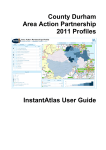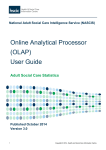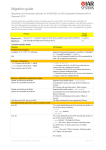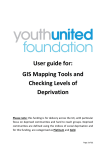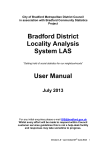Download POPPI User Guide
Transcript
Care Services Efficiency Delivery Demand Forecasting and Planning POPPI 5.1 User Guide POPPI stands for Projecting Older People Population Information. It gives easy access to projections of the numbers, characteristics and care needs of people over 65 in England at national, regional and council level. With PANSI covering the 18-64 age groups, POPPI and PANSI bring together relevant information for council planners and commissioners of adult social care and provide a consistent starting point for Joint Strategic Needs Assessment. POPPI 4 introduced a new, wider screen format showing: ‘Comparator’ authorities using the CIPFA model A ‘Neighbours’ menu for adjoining councils Government Office Region and other authorities in the GOR Users own groups of up to 15 councils, regional and England totals POPPI 5 gave users the ability to compare data across councils, regions and the new menu groups to download data for many geographical locations. POPPI 5.1 introduces: an interactive map for navigation to councils, districts and regions ONS population projections for the City of London and the Isles of Scilly population projections for the 90+ age-band projections of dementia for the 85-90 and 90+ age-bands by gender 2010 data on state pension recipients POPPI and PANSI use ONS forecasts based on current trends. They do not predict ‘expected’ outcomes. Often, the strategic direction will aim to avoid the outcomes that POPPI projects. [See ‘Using POPPI’ below] POPPI and PANSI are developed and supported by the Department of Health CSED Programme and the Institute of Public Care, Oxford Brookes University [IPC]. POPPI 5.1 User Guide Page 2 REGISTERING WITH POPPI PANSI users are already registered. If you have not registered to use PANSI, go to www.poppi.org.uk, choose 'Click here to register' and complete the on-line form with: Name, job title and organisation Office address and phone number Email address POPPI automatically sends a unique password to UK local and national government, NHS or academic e-mail addresses. For other e-mail addresses, please supply the additional information requested to facilitate your registration: Service providers: are you registered with CQC? Charities: please give your registered charity number. Others: please state why you wish to use POPPI. When your registration is accepted, POPPI will send a password to your e-mail address. Once logged-in, you can change your password using the ‘My account’ screen from the menu top right. There is a forgotten password link on the login page. Your password, with the registered e-mail address as your username, allows you to access both POPPI and PANSI from any location. In PANSI and POPPI, links allow you to switch between the sites where tables have the same content. This makes it easy to view data for all adult age-bands and the total population forecast. The login page also has information on recent and planned updates to the data and the system and a link to download the User Guide. If you have any problems or queries, contact the Institute of Public Care: Telephone: 01225 484088 (9am to 5pm Monday to Friday) and ask for the helpdesk or email: [email protected] Changes from POPPI Version 5.0 are highlighted in this User Guide. Care Services Efficiency Delivery (CSED) December 2010 POPPI 5.1 User Guide Page 3 POPULATION PROJECTIONS After logging in, you will see the Office for National Statistics [ONS] population projections for your council. For non-council users, the screen displays the results for England - but users can nominate a default locality through ‘My account’. This table is an example of baseline population forecasts by age in POPPI: POPPI uses ONS Subnational Population Projections published 27 May 2010. Long-term population projections are an indication of the trends in population by age and gender. They are based on 2008 mid year population estimates and assumptions on future levels of births, deaths and migration based on observed levels mainly over the previous five years. They show what the population would be if recent trends continue and do not take account of future policy changes. POPPI 5.1 replaces the 85 and over age-band with two bands: 85-89 and 90+. Care Services Efficiency Delivery (CSED) December 2010 POPPI 5.1 User Guide Page 4 Population figures On the left hand side of the screen, menu options under Population figures lead to tables for: Population forecasts by age for 2010, 2015, 2020, 2025, 2030 Total population forecast with percentages of the over 65s and over 85s in the total population Population forecast by gender and age band Proportion by gender and age band 2007 population estimates by ethnic group and age band - numbers and percentages. [POPPI uses the experimental ONS estimates of ethnic group by age band published in April 2009.] Religion by age and by gender from the 2001 census. DWP data on the proportion of pensioners receiving state pension only with no other benefits [a measure of relative affluence] – updated to May 2010 Household growth – and the proportion headed by older people The active menu option is marked with a red dot. Percentage change Select ‘Show percentage change’ on the Population by age and Population by gender and age pages to show the projected percentage growth from the current year [2010] to 2015, 2020, 2025, 2030. ‘Show numbers’ reverts to the projections. Near-term population projections Choose 'Show next five years' to show population data for the years 2010-2014. This feature is available on all pages showing forecasts over time. Choose 'Show 2010 to 2030' to return to 2010, 2015, 2020, 2025, 2030. The Notes on each page identify data sources with tables of the prevalence rates used. The rates and source references are downloaded with the projections when the Download facility is used. Care Services Efficiency Delivery (CSED) December 2010 POPPI 5.1 User Guide Page 5 NAVIGATION TO OTHER GEOGRAPHICAL LOCATIONS With Menus You can view information for any local authority, Government Office Region (GOR) or for England as a whole. The drop-down menu, top right lists councils with social services responsibilities [CSSRs] in alphabetical order, after England and the 9 GORs. To change location, on any page, scroll down the list [top right], highlight the required location and then click once to display the data. To view district data, select the relevant county council; then use the drop-down ‘Select a district’ menu, immediately beneath, to select the district required. In POPPI, menu groups make it easier to navigate to other relevant councils. Choose ‘Go to a comparator’ for each authority’s closest fifteen comparators using the CIPFA ‘Nearest Neighbour’ Model – useful for benchmarking. Choose ‘Go to a neighbour’ to list councils adjoining the selected authority – useful for coordinating strategy and potential cross-border impacts. ‘Region’ allows users to select other authorities in their GOR and the regional total. Users can also build up three of their own ‘Favourites’ groups of up to 15 localities from local authorities, GORs and England. To add, remove and name selections use the ‘Organise favourites’ menu on the right. [See Facilities section for more details.] POPPI uses district data to provide a planning base for the four new unitary authorities in Bedfordshire and Cheshire. District level detail is retained for the five counties that have converted to unitary authorities in 2009. POPPI 5.1 includes population projections for the City of London and the Isles of Scilly with their neighbours and other authorities in the London and South West Regions respectively. Data for Cornwall now excludes the Isles of Scilly. CIPFA comparators are not yet available for the City and the Isles of Scilly. With Maps Users can navigate between geographical areas using a map covering England, the regions, unitary authorities, counties and districts. Choose ‘Show map’ below the drop down menu top right to display a map. Click on the map to select a location. Use the map menus to move up from districts to counties and up from authorities to regions. Choose ‘Close map’ to close the map and view data for the selected location. Users can move across the country as well as focus in on areas where authorities are densely packed, for example, in the Greater Manchester area. Maps are supplied by the Information Centre for Health and Social Care. Care Services Efficiency Delivery (CSED) December 2010 POPPI 5.1 User Guide Page 6 LOCAL POPULATION CHARACTERISTICS POPPI contains information on the characteristics of the population in each council in terms of: Living status Living alone Transport - pensioners living alone, with and without transport Tenure Living in a care home Without central heating Support arrangements Provision of unpaid care Unable to manage domestic tasks Unable to manage self-care The source is the 2001 census unless more recent prevalence information is available. The sources, and the prevalence rates used, are set out on each page. Multiple characteristics Some combinations of characteristics are analysed in the ‘Multiple characteristics’ pages: Tenure/illness Ethnicity/illness Ethnicity/Illness – proportions General health/unpaid care Unpaid care/age/hours Limiting long term illness/living alone These tables show how the characteristics are linked in the particular district based on the 2001 census data. Applying the characteristics to the forecast of population by age gives a starting point for population analysis. The characteristics can change over time but the relative values – between districts, counties and unitary councils – will persist in the medium-term. Care Services Efficiency Delivery (CSED) December 2010 POPPI 5.1 User Guide Page 7 HEALTH PREVALENCE INFORMATION Under ‘Health’, POPPI also contains information from published research and surveys on the prevalence of the following health conditions that are likely to affect the care needs of the elderly population. Limiting long-term illness Depression Severe depression Dementia – now with projections of dementia for 85-90 and 90+ age-bands by gender Heart attack Stroke – with ‘all ages’ option Bronchitis\emphysema Falls – A&E attendance Falls – hospital admissions Continence Visual impairment – with ‘all ages’ option Hearing impairment – with ‘all ages’ option Mobility Obesity Diabetes – with ‘all ages’ option Select ‘Health’ then the appropriate condition button to show the potential numbers of people affected by the condition locally - estimated by applying the prevalence rates to the local population projections. Each page presents data for all persons with a ‘Show by gender’ button to display the gender breakdown. POPPI focuses on older people but some physical disability and learning disability conditions apply to all ages. To help strategy development for these conditions, users now have a ‘See all age ranges’ option. This is available for Stroke, Diabetes, Visual impairment, Hearing impairment and Learning Disability. Data sources and tables of the prevalence rates used are identified in the Notes to each page. The rates tables and source references are downloaded with the projections when the Download facility is used. Councils should make judgements about the relevance and validity of the prevalence rates to their locality. Care Services Efficiency Delivery (CSED) December 2010 POPPI 5.1 User Guide Page 8 OLDER PEOPLE AND LEARNING DISABILITIES Select ‘Learning disability’ from the left hand menu. Four pages are available: LD – Baseline estimates LD – Moderate or severe Down's syndrome Down's syndrome/dementia LD – Baseline and Moderate or Severe tables show the numbers of people over 65, by age, predicted to have a learning disability, projected to 2030. The predictions are based on prevalence rates from a report by Eric Emerson and Chris Hatton of the Institute for Health Research, Lancaster University, ‘Estimating Future Need/Demand for Supports for Adults with Learning Disabilities in England’ June 2004. Percentage change Selecting ‘Percentage change’ on the ‘LD – moderate or severe’ page shows the projected percentage change from the current year [2010] to 2015, 2020, 2025 and 2030. The Down's syndrome table shows numbers of people over 65, by age, predicted to have Down’s syndrome to 2030. Estimates are based on the numbers of people with Down’s syndrome from original work by IPC based on the Sheffield Learning Disability Case Register, October 2007. Down's syndrome\dementia shows the numbers of people over 65 with Down’s syndrome predicted to have dementia to 2030. Prevalence rates are from a Dutch study by A Coppus el al, "Dementia and mortality in persons with Down's syndrome", published in the Journal of Intellectual Disability Research, October 2006. Care Services Efficiency Delivery (CSED) December 2010 POPPI 5.1 User Guide Page 9 LOCAL SERVICES PROVIDED POPPI uses a subset of the latest Social Care Indicators from the National Indicator Set 2008-09 and RAP returns related to services for older people. Data is now sourced from: Social Care Indicators from the National Indicator Set 2008-09 final, http://www.ic.nhs.uk/pubs/socmhi08-09 National Adult Social Care Intelligence Service (NASCIS), Referrals, Assessments and Packages of Care data (Final 2008/09 data), http://nascis.ic.nhs.uk/Default.aspx National Adult Social Care Intelligence Service (NASCIS), Adult Social Care Combined Activity Returns data (Final 2008/09 data), http://nascis.ic.nhs.uk/Default.aspx POPPI 5 includes projections based on the 2008/09 returns of the numbers receiving each service adjusted for the increase in population – if rates as a proportion of the elderly population continue. The figures represent the potential demand and not the expected demand or the desired outcome. Select ‘Services provided’ from the main menu. Projections are provided for the number of people over 65: Helped to live independently [NI 136] Receiving intensive home care - now includes all adults over 18 [RAP H1] Receiving community based services [RAP P2] Residents supported in care homes [RAP S1] Admitted to permanent residential and nursing care [RAP S3] Carers receiving services [NI 135] A new page in POPPI, ‘Direct payments’, projects the number of people receiving self-directed support based on 2008-09 data sourced from the National Indicator Set [NI130]. Note that the planned increase in individual budgets and direct payments is likely to be much greater than this population-driven projection. A full description of the indicators is given in the table notes. For the new councils, POPPI uses the predecessor county [Bedfordshire or Cheshire] performance rates applied to the new authority population. Services provided data is not available for District councils. Care Services Efficiency Delivery (CSED) December 2010 POPPI 5.1 User Guide Page 10 FACILITIES My Favourites Users can build up three of their own Favourites groups of up to 15 localities from the list of local authorities, GORs and England. To add, remove and name favourite selections select the Organise favourites menu option on the right, and then: Use the dropdown menu to select a geographical location, then use the ‘Add to group...’ buttons to add each location into the group. Give each group a name by clicking on ‘Enter a nickname for group...’, type a name into the box, choose Save. Choose ‘Edit nickname’ to change the name. To remove a location from a group click on next to the location name. To empty the contents of a group click on at the top of the group. To return to the tables, choose a data page using the menu on the left or choose the ‘Return to Population by age’ menu option on the right. Groups will be listed at the end of the right hand panel, click on the group name to list the contents, click a location name to display data. Compare Data The following datasets are now available for comparison in POPPI: Total population 65 and over for 2010 to 2030 plus next five years Percentage change in population by age band by 2020 Population aged 65 and over as a proportion of the total population for 2010 to 2030 plus next five years Population aged 85 and over as a proportion of the total population for 2010 to 2030 plus next five years Ethnic group percentage by age band: 65-74; 75-84; 85+ Projected increase in households aged 65 and over as a proportion of the increase in all households Helped to live independently Receiving intensive home care Supported residents in care homes On each page where the above datasets appear, the ‘Compare’ icon - a set of unbalanced scales - appears. Compare A small ‘Compare’ icon indicates datasets - rows or columns - that can be compared. Clicking on a Compare data icon will display a set of choices. Users can: Care Services Efficiency Delivery (CSED) December 2010 POPPI 5.1 User Guide Page 11 Choose the dataset required (where there is more than one dataset available for comparison on the page); Choose the group of geographical locations to compare – including ‘My favourites’ groups where these have been set up. The results of a comparison are presented in a table format on screen, together with the original Notes, with the ability to print or download as for standard tables. If you began at ‘Percentage change’ or ‘Next five years’ data, this choice is retained on the comparison table. If ‘Next five years’ or ‘Percentage change’ buttons are present when a comparison table is shown, these buttons function for the data in the comparison table. To return to the original datasets, users can choose: The ‘Stop comparing’ option; The same page or a different page from the left hand menu; A different geographical location from the right hand set of menus. Download With POPPI 5, users can download data from a standard page for more than one geographical area into a single Excel spreadsheet. Clicking the ‘Download’ icon above the data table opens a menu offering a choice of localities for which the data can be downloaded: The currently selected local authority only The currently selected local authority plus its 15 comparators The currently selected local authority and its geographical Neighbours All authorities within a region plus the region itself Any ‘My favourites’ group All government office regions plus England All districts within a County plus the County itself The format for the data download, when opened in a spreadsheet, is: The title information appears at the top. Each component table appears one below the other. Table column headings appear once, e.g. years. Row labels are preceded by location name. Total rows remain. The Notes appear once, after the last data table. The naming convention for downloaded data identifies the geography covered. For example: poppi_Population_by_age_London_14-07-10.csv poppi_Population_by_age_Gloucestershire_and_neighbours_14-07-10.csv poppi_Population_by_age_Hampshire_and_districts_14-07-10.csv Care Services Efficiency Delivery (CSED) December 2010 POPPI 5.1 User Guide Page 12 Date/time stamp and version numbers All downloaded files include information to denote the date and time the file was produced, and the version number of the system current at the time. For example: Data for: England Table produced on 19/07/2010 10:05 from www.poppi.org.uk version 5.0 Population aged 65 and over, by age, projected to 2030 2009 2015 2020 2025 2030 People aged 65-69 2,349,200 2,952,500 2,695,900 2,945,600 3,364,100 People aged 70-74 2,032,300 2,248,600 2,753,800 2,527,400 2,771,600 People aged 75-79 1,657,700 1,821,000 2,018,500 2,490,100 2,300,100 People aged 80-84 1,232,800 1,342,000 1,518,800 1,711,600 2,129,000 People aged 85 and over 1,154,000 1,350,400 1,576,000 1,912,900 2,314,800 Total population 65 and over 8,426,000 9,714,500 10,563,000 11,587,600 12,879,600 Figures may not sum due to rounding. Crown copyright 2008 Print The Print facility [top right of the data table] will print the current table of figures as a report and not the whole browser screen. The printed page includes the local authority name, the table title, figures, totals and source information plus "Population data is Crown copyright 2010". Note: the Print function does not print multiple location tables. Care Services Efficiency Delivery (CSED) December 2010 POPPI 5.1 User Guide Page 13 User Questionnaire The User Questionnaire facility in POPPI enables electronic surveys of user requirements and preferences. The survey questionnaire will appear in a new window on logging in to POPPI. Users have the choice of delaying or declining the questionnaire and the window will remain open until one of the options is selected, allowing the user to browse within POPPI and return to the questionnaire later. Useful Links Useful links – on the top menu bar – opens a page of related sites, including links to datasets with additional geographical detail [scroll down for the full list] and sources used in POPPI and PANSI. Including: Super Output Area - LSOA and MSOA - mid-year population estimates for England and Wales for mid-2002 to mid-2008 (experimental) Ward level population estimates for England and Wales for mid-2001 to mid-2007 (experimental) Further measures of poverty, benefits and deprivation can be accessed from links to: Department for Work and Pensions, Resource centre: Tabulation tool Communities and Local Government, Indices of Deprivation 2007 RNIB Pension Credit information. About, Help, Contact us, My Account and Logout On the top menu bar, these links provide the following information and functions: About – System description and version numbers Help - How to use the system with PDF versions of the User Guides to both POPPI and PANSI for downloading Contact us – Telephone number and e-mail link to IPC Helpdesk My account – Form for editing account details and password with full Terms and Conditions of use Logout – To exit the system Care Services Efficiency Delivery (CSED) December 2010 POPPI 5.1 User Guide Page 14 USING POPPI POPPI is designed to be flexible and easy to use. Whether the need is for a quick check on population forecasts or detailed development of service strategy, the information is readily available. Systems expertise and analytical skills are not required to access key data. Strategic Planning Applications POPPI 5 gives council users a fully updated planning base for the 2010/11 planning cycle and significant additional analytical functionality. POPPI projects at the total population level – not just service users – and is ideally suited to Joint Strategic Needs Assessment [JSNA]. If this is joint work, with a coterminous PCT, NHS users can register and can access the common dataset. Care services provided by councils are often a residual element in the care of older people – after informal care and self-payers. Councils often have little information on informal care and self-payers and POPPI can help with the Strategic Gap Analysis. Understanding the total picture is an important element of JSNA and the interaction between publicly funded care, informal care and self-payment will be critical to managing future demand for care and planning care services. POPPI can help to generate the assumption base for operational planning and demand monitoring – vital to detecting emerging trends in demand. Service strategy development involves understanding the range and prevalence of conditions and needs likely to be encountered in future. POPPI can provide an initial quantification of these needs as a baseline scenario. The total population perspective is essential for development of the Universal Services element of Putting People First. The Compare facility allows councils to view the characteristics of neighbours, CIPFA comparators, regional and national averages to identify potential benchmarking opportunities. POPPI data can be downloaded to Excel for generating alternative scenarios, varying assumptions or applying local knowledge. The downloaded spreadsheets can be used for chart and graph creation or insertion into reports and presentations. Downloading data for multiple locations into a single spreadsheet meets user requests and significantly extends this capability. Commissioning Applications The capacity to understand and forecast future demand is an important component of proactive commissioning across health and social care. POPPI offers commissioners a practical and straightforward way to analyse population data, identify key characteristics within that population, project numbers into the future using ONS population projections and compare future populations against performance data. Population based analysis forms a valuable backdrop for service planning, market development and demand management. Indicating the prevalence of conditions that may require a social care response. Care Services Efficiency Delivery (CSED) December 2010 POPPI 5.1 User Guide Page 15 Understanding strike rate, i.e. the numbers of people in particular circumstances or with particular conditions encountered by social care/health care/housing compared with their prevalence within the population. Exploring the relationship between population locations and service and community facilities. Helping to identify the numbers of people to contact, within particular target populations, in moving from a reactive to a proactive service. Future Applications POPPI was launched at a time of significant change in health and social care. The system was designed to provide information for councils and PCTs in a dynamic environment with changing population profiles of older people and innovations in commissioning and consumer choice across the health economy. Registration is open to service providers, charities and commercial organisations with an interest in the field, to make the information widely available. There are now 6,800 registered users spread across all county and unitary authorities and every PCT in England as well as many other organisations. The users of POPPI have already provided valuable feedback on content and functionality and many of the improvements highlighted in this user guide are a direct result of this, much appreciated, support. CSED and IPC will continue to seek user feedback to identify the priorities for future development and opportunities for added-value enhancements. CSED Contact: Ray Beatty 0207 972 1017 [email protected] IPC IT Support: 01225 484088 [email protected] Care Services Efficiency Delivery (CSED) December 2010




















